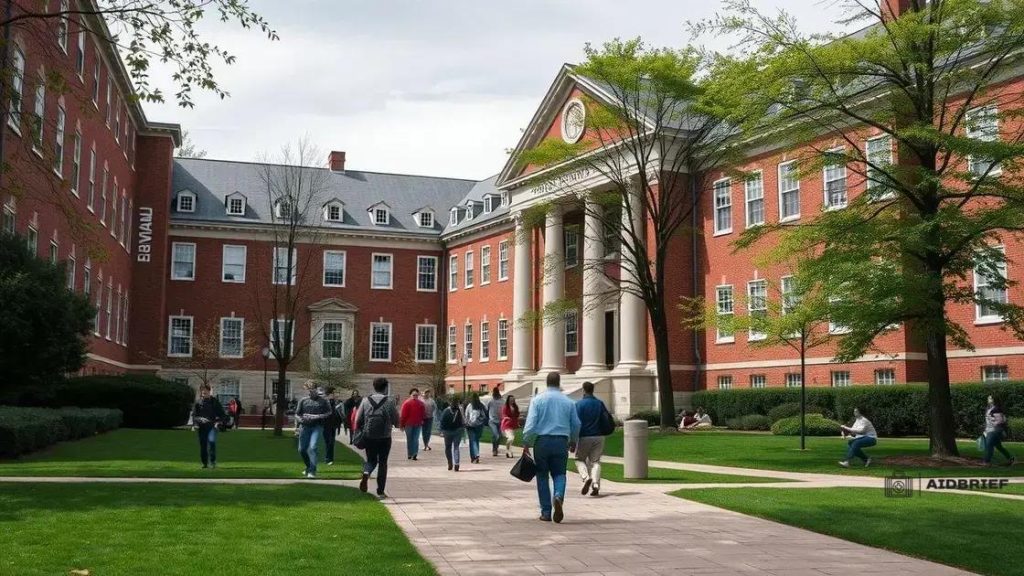Harvard fund freeze: what it means for students

The Harvard fund freeze significantly impacts student life and resources, prompting students to engage in advocacy, seek alternative funding, and maintain community connections to navigate the challenges effectively.
The Harvard fund freeze has raised eyebrows among the student body and faculty alike. This move has implications that reach beyond the financial aspect, affecting student life and academic resources. But what exactly does this mean for you?
Understanding the Harvard fund freeze
Understanding the Harvard fund freeze
is crucial for students and faculty alike. This decision impacts not just finances but the entire ecosystem of campus life. The reasons behind such a freeze can vary significantly, and it’s important to explore those in detail.
Reasons Behind the Fund Freeze
Several factors could lead to a fund freeze at a prestigious institution like Harvard. Budget reallocations, decreased revenue, or unexpected expenses can all contribute to such a decision. When funds are paused, it often means that the university is reassessing its priorities and financial strategies.
Some main reasons for experiencing a fund freeze include:
- Declining donations and endowments
- Increased operational costs
- Shifts in financial priorities
- Economic pressures from external factors
Another aspect to consider is how the Harvard fund freeze can affect various departments. Academic programs may face cuts or restructuring, impacting the quality of education students receive. Moreover, student services, which are often funded through these allocations, can also see significant reductions.
The Impact on Student Life
As funds are frozen, students might notice changes across campus. From limited resources in libraries to cutbacks on extracurricular programs, the ripple effects can be felt widely. It’s essential for students to stay informed about these developments and understand how they can adapt.
One key area affected by this freeze is student support systems. Accessibility to mentors, advisors, and basic facilities could be compromised, leaving students to navigate challenges alone. Community engagement may also take a hit if events and programs are scaled back.
Ultimately, the Harvard fund freeze represents a pivotal moment for the university, raising questions about the sustainability and future direction of campus resources. By keeping informed and engaged, students can voice their concerns and contribute to discussions aimed at restoring vitality to their university experience.
Reasons behind the fund freeze
The reasons behind the fund freeze at Harvard are multifaceted and complex. Understanding these reasons helps students and faculty to grasp the broader implications for the university community. Financial challenges and shifting priorities contribute significantly to this situation.
Budget Constraints
One of the primary reasons for a fund freeze can be attributed to budget constraints. As universities face increasing operational costs, they may need to reassess their financial commitments. This reassessment often leads to cutting or freezing funds to maintain overall fiscal health.
Factors influencing budget constraints include:
- Decreased state funding
- Lower enrollment numbers
- Increases in student aid
- Unforeseen expenses, such as facility repairs
When funding is tightly managed, universities sometimes opt to impose freezes as a temporary measure while they develop a long-term strategy to stabilize finances.
Economic Pressures
Besides internal financial issues, external economic pressures play a significant role in initiating a fund freeze. Changes in economic conditions, such as recessions, can affect donations and endowments, which are critical to university funding.
Such economic factors may include:
- Fluctuations in the stock market
- Shifts in donations from alumni and local businesses
- Global economic downturns impacting overall funding
Institutions like Harvard rely on a broad network of donors, and when those contributions decline, the ripple effects can lead to immediate funding freezes.
Lastly, internal decisions made by the administration regarding the direction of the university can influence financial stability. Strategic changes aimed at enhancing academic programs may temporarily shift funding away from other areas, leading to freezes in previously allocated budgets. By understanding these reasons behind the fund freeze, students can better navigate the implications it has on their education and campus life.
Impacts on student life and resources

The impacts on student life and resources due to the fund freeze at Harvard are significant and far-reaching. When funding is restricted, students may experience firsthand the limitations placed on various aspects of their academic and social experiences.
Effects on Academic Programs
One immediate impact is on academic programs. With less available funding, departments may face cuts in course offerings or faculty positions. This can lead to overcrowded classes, reduced access to essential courses, and potentially a decline in the quality of education. Students may find it more challenging to engage deeply in their studies and may have to shift their educational paths as a result.
Some specific impacts on academic programs include:
- Fewer elective choices available
- Increased class sizes and decreased one-on-one support
- Loss of specialized lecturers and adjunct faculty
Furthermore, research opportunities, which significantly enhance the academic experience, might also be impacted. Many students rely on research funding for projects, and the freeze could mean limited access to grants and resources necessary for student-led initiatives.
Changes in Student Services
Another area significantly affected is student services. Resources like counseling, academic advising, and student organizations rely heavily on university funding. These essential services help students navigate their college experience, but with a fund freeze, availability may become limited.
Some critical changes in student services might include:
- Reduced hours for counseling centers or study spaces
- Fewer events or activities organized by student groups
- Increased difficulty in accessing academic support and tutoring services
As students face these challenges, the social aspect of college life may also suffer. Engaging in extracurricular activities is vital to building community and fostering friendships. A decline in activities may lead to feelings of isolation among students, affecting their overall well-being.
In summary, the impacts on student life and resources due to the fund freeze extend beyond finances. They touch upon the core educational experience, making it imperative for students to advocate for themselves and stay informed about how these changes affect their journey at Harvard.
Possible future scenarios for students
Considering the possible future scenarios for students amidst the Harvard fund freeze reveals several potential outcomes. Each scenario carries its own implications for students’ academic experience and overall college life.
Increased Financial Aid Applications
One possible scenario is an increase in financial aid opportunities. With the fund freeze, the university may recognize the need to support students more effectively. This could lead to expanded scholarships, grants, or work-study programs to help alleviate financial burdens.
Students might see more funding options available such as:
- Targeted scholarships aimed at those most affected
- Improved outreach for financial aid applications
- Short-term grants to cover emergency expenses
This increased support could provide essential relief for students facing heightened financial challenges during the freeze.
Changes in Academic Offerings
Another scenario might involve significant changes in academic offerings. Departments could reevaluate course structures, possibly leading to the elimination or creation of programs based on students’ current needs and interests.
This could result in:
- Increased online learning options
- More interdisciplinary courses combining different fields
- Adaptive curriculum focused on essential job market skills
Such adaptations could pave the way for more relevant education aligned with future workforce demands.
In contrast, some programs may face cuts due to budget constraints, which could limit students’ choices and intensify competition for the remaining spots in popular courses. As a response, student advocacy would likely increase, pushing for courses that enrich the academic community.
Stronger Student Organizations
Another potential outcome is the emergence of stronger student organizations. In challenging times, students often unite to advocate for their needs and interests. This could lead to enhanced collaboration among different groups, promoting community and resilience.
Benefits of stronger student organizations could include:
- Increased support networks
- More significant advocacy power in university decisions
- Increased involvement in university affairs
Overall, these possible future scenarios for students highlight the various ways the Harvard fund freeze might influence student life. Adapting to these changes will require resilience, cooperation, and a proactive approach from the student body.
What can students do during the freeze?
Understanding what students can do during the freeze is crucial for adapting to changes in their academic environment. Navigating the implications of a fund freeze requires proactive measures and constructive actions.
Engage in Advocacy
One essential step students can take is to engage in advocacy. By voicing their concerns and needs, students can influence university decisions. Joining student organizations or creating new groups focused on advocacy can amplify their voices.
Some specific actions include:
- Organizing informational meetings to discuss issues
- Creating petitions to present to the administration
- Engaging in dialogue with faculty and staff
Advocacy empowers students to be part of the conversation about their education and resources. It can foster a sense of community and shared purpose.
Explore Alternative Resources
During the fund freeze, students should actively seek alternative resources. They can look for external scholarships, grants, or part-time job opportunities to help mitigate financial constraints. Local organizations, non-profits, and even crowd-funding platforms can provide additional support.
Consider these options:
- Research local scholarships and funding opportunities
- Apply for internships that offer stipends or benefits
- Utilize community resources such as food banks or housing assistance
Finding these resources can lessen the impact of the freeze on their lives.
Maintain Community Connections
Staying connected with peers is another vital aspect of managing this challenge. Students can form study groups or participate in online forums to share resources and strategies for coping with the freeze. Building a network of support can provide both emotional and practical assistance.
Maintaining community connections helps in several ways:
- Encouraging collective learning and collaboration
- Providing emotional support during challenging times
- Sharing information about available resources or opportunities
Ultimately, taking initiative during the freeze can lead to positive outcomes. Students can focus on their personal and academic growth, adapt to changes, and find meaningful ways to navigate this period.
FAQ – Frequently Asked Questions about the Harvard Fund Freeze
What should students do during the fund freeze?
Students can engage in advocacy, explore alternative resources, and maintain community connections to navigate the challenges.
How can students advocate for their needs?
Students can join organizations, create petitions, and engage with faculty to voice their concerns effectively.
Are there any alternative resources available for financial support?
Yes, students can research scholarships, apply for internships, and utilize community resources to support themselves during the freeze.
Why is community connection important during the fund freeze?
Maintaining connections helps students share resources, provide emotional support, and collaborate on solutions to common challenges.





